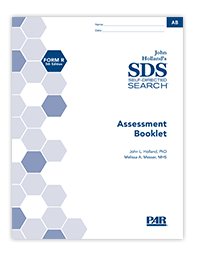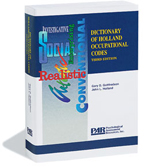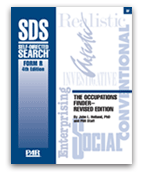
The Self-Directed Search® has been used by more than 30 million people worldwide and has been translated into more than 25 languages. There are a number of career assessments on the market, yet the SDS continues to be extremely successful. What sets it apart? Recently, PAR had the opportunity to catch up with two SDS experts, Robert Reardon, PhD, and Janet Lenz, PhD, both from the Career Center at Florida State University and widely published in the career counseling arena. Reardon and Lenz have worked closely with SDS author John Holland as collaborators and authors of many SDS-related publications, including The Self-Directed Search and Related Holland Materials: A Practitioner’s Guide (PAR, 1998).
The SDS is based on Holland’s career theory, which argues that vocational choice is an expression of personality, and that by identifying certain personality characteristics and preferences, better career choices can be made. “People often feel overwhelmed about how to relate their self-knowledge to career options,” says Reardon. “The SDS gives them a way to intuitively and logically make that connection.” One of Holland’s most important contributions was his identification of the personality and environmental characteristics that have become known collectively as RIASEC: realistic, investigative, artistic, social, enterprising, and conventional. These factors form the basis of the SDS.
Reardon and Lenz have worked with the SDS for nearly 40 years, and they have seen it develop in response to career counseling research and new technology. “Our counseling service started using the SDS in 1973 because it included a self-help feature that we knew would be useful to our clients,” they explain. “Holland took note of what we were doing and was supportive along the way.”
Reardon and Lenz have been deeply involved in revisions of the SDS, and they have been key players in updates and revisions to many of the individual elements in the SDS product family, such as the interpretive report generated by the SDS software. But what keeps these products current and relevant? “The SDS is informed by both practice and research,” they explain, “and we continue to draw upon both to keep SDS materials current and relevant. For example, the revised Occupations Finder published in 2010 is very important because it now connects the SDS to the O*NET system of occupational information, which is online and updated constantly. Unlike many other assessments, the SDS embraces users—after all, ‘self-directed’ is in the title—and this user perspective helps to keep the SDS relevant.”
Today, using the on-screen administration, clients can complete the SDS electronically on a laptop computer, a tablet, or even an iPhone® or Android device. For college students and other clients living in this era of instant information, the SDS has kept pace by providing a fast, accessible, portable, and reasonably priced tool that can help them gain real insight into making good choices about career.
In the category of reliable, valid, theory-based instruments, the SDS is one of the most user-friendly, and it is very easy for practitioners to use with clients. “Some have described the SDS as simple,” say Reardon and Lenz, “but when fully interpreted and connected to Holland’s theoretical constructs (for example, congruence, differentiation, coherence, consistency, vocational identity), it provides a rich source of information for both clients and practitioners to discuss and incorporate into a plan for next steps. The information not only addresses self and option knowledge, but it provides diagnostic data about the client’s ability to move effectively through the career decision-making and problem solving process.”
As the SDS has evolved, it has always been research-based; through the years, more than 1,600 published studies have examined, evaluated, and supported Holland’s career theory. Reardon and Lenz have themselves collaborated in more than 35 publications related to the SDS and RIASEC theory. “Over time, our interest in the SDS has deepened as we learned more about the instrument, not only from our own research, but from hundreds of studies and articles that were published as more practitioners adopted the SDS and more researchers began to consider it.”
“One of the things we’ve seen from doing workshops with counselors all over the country is how many different settings and with how many different client populations the SDS has been used successfully,” say Reardon and Lenz. “It’s been rewarding to see how it has helped so many people become more effective career problem solvers.”
To learn more about the Self-Directed Search and other materials related to career intervention services and resources, visit the SDS product page on PAR’s Web site; to take the SDS online right now, click on http://www.self-directed-search.com/default.aspx.
Filed under: PAR Author, Products | Tagged: assessment, career, career counseling, career interest inventory, career transition, Holland Code, John Holland, Occupations, SDS, Self-Directed Search | Leave a comment »
 Beyond the technical requirements of the job, what are the workplace personality traits that lead to success in a specific work environment? Understanding the personality traits needed for a particular job or workplace can be the key to a good career choice—a match that works for both employee and employer.
Beyond the technical requirements of the job, what are the workplace personality traits that lead to success in a specific work environment? Understanding the personality traits needed for a particular job or workplace can be the key to a good career choice—a match that works for both employee and employer.

 PAR is delighted to announce the release of the new
PAR is delighted to announce the release of the new 

